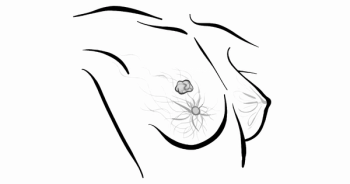
PARP Inhibitors Still Alive, But Not Alone, in Triple-Negative Breast Cancer
PARP inhibitors are anything but dead as breast cancer treatment, argued Patricia LoRusso, DO.
“PARP inhibitors are alive and well, and we’ve just begun to understand where they fit into the arsenal of treatment, with not only triple-negative breast cancer (TNBC), but other types of breast cancer as well,” said LoRusso, a professor of medicine and associate director of innovative medicine at Yale University.
PARP inhibitors are potential treatment strategies against triple-negative tumors, which account for about 15% of all breast cancers in the United States, said LoRusso. Of these, 70% harbor theBRCA1mutation, she said, and 20% theBRCA2mutation.
This drug class targets poly (ADP-ribose) polymerase, a pivotal protein in the repair of strand breaks in DNA. “DNA repair is really quite important in breast cancer cells in general because that’s what allows them to continue to grow and metastasize and obviously kill the host,” explained LoRusso. In patients withBRCA-mutated cells, PARP inhibitors increase DNA double-strand breaks and the death of homologous recombinationdeficient cells, contributing to cell death. In normal cells, noted LoRusso, even with PARP inhibitors present, the cells can repair by homologous recombination and the tumor cells goes on to survive and do further damage.
The scientific relevance of PARP inhibitors may extend beyond TNBC withBRCAmutations, however.
“When we give PARP inhibitors, we’re not only probably impacting the mechanism or the function we thought in terms of DNA repair, but there are other functions that are probably also being impacted with the utilization of PARP inhibitors,” said LoRusso. “This is especially important when we start to look at mechanisms of resistance and mechanisms of response in patients who do not harborBRCAmutations.”
LoRusso said she’s currently interested in a clinical trial of patients with TNBC withoutBRCAmutations, looking at whether hypoxia induction could induce what is calledBRCA-ness, a phenomenon first identified by researchers in 2005.1“It isn’t necessarily the development of theBRCAgene mutation, but rather with chronic exposure to hypoxia, many of these cells had decreased homologous recombination repair, thus not allowing them to restore their double-stranded DNA, as well as a decrease in MMR repair which leads to genetic instability and potentially an altered therapeutic response to PARP inhibitors.”
PARP inhibitors have moved beyond olaparib, the first FDA-approved PARP inhibitor and considered the “gold standard,” said LoRusso, with many being investigated in ongoing clinical trialsamong them cediranib, veliparib, and olaparib.2
In patients with TNBC, LoRusso said she’s interested in a clinical trial which looked at giving these patients cediranib as a sensitizer to olaparib, to induce hypoxia and thus create BRCA-ness.
Platinum agents also can cause intragenic mutations, explained LoRusso, another mechanism of resistance to PARP inhibitors; these secondaryBRCAmutations pose another challenge for this class of drugs. “One of the primary mechanisms of resistance is restoration of the functionality of theBRCAgene, wherein treating these patients, you get a secondary mutations inBRCA1and2that restore the mechanism of this gene and then prevent the drugs from working because now these genes can work in homologous recombination, overriding the mechanism of the PARP inhibitor.”
Combination therapies of irinotecan and veliparib have also received significant sustained responses in patients withBRCAmutations, even in those with platinum resistance, said LoRusso.
LoRusso suggested that monotherapy sequencing may not be as important as combination interventions for patients with TNBC, but, she added, “We have to be cautious as to how we use PARP inhibitors and how we sequence drug combinations and drug therapies inBRCA-mutant patients in hopes of maximizing the effect of these drugs.”
The main question going forward, posited LoRusso, is how can PARP inhibitor activity be enhanced?
To this end, said LoRusso, the I-SPY2 trials testing combinations of talazoparib and CPT11, and veliparib and carboplatin,3have proved themselves in the neoadjuvant settings. “These two combinations in this trial are going to be extremely informative in how we enhance PARP inhibitors.”
“When these agents were being developed, nobody thought of using them in the adjuvant or neoadjuvant setting. And perhaps this is the absolute best place to personalize this class of drugs before their tumors have been poisoned by platinums and developed resistance to other therapeutic interventions. Perhaps in this select small group of patients, we can make a difference in terms of a cure, with the use of PARP inhibitor therapy,” said LoRusso, who argued for the continued development of this class of agents.
References
- Bindra, RS, Crosby, RE, Glazer, PM, Regulation of DNA repair in hypoxia cancer cells.Cancer Metastasis Rev. 2007;26(2):249-60.
- Sonnenblick A, deAzambuja E, Azim HA Jr, Piccart M. An update on PARP inhibitorsmoving to the adjuvant setting.Nat Rev Clin Oncol. 2015;12(1):27-41.
- Rugo HS, Olopade OI, DeMichele A, et al. Adaptive randomization of veliparib-carboplatin treatment in breast cancer.N Engl J Med. 2016;375(1):23-34.
“The best data, the most informative data, and the greatest probability of benefit for our patients will be in forthcoming studies and hopefully they, too, will make a difference in the personalized approach to cancer therapy.”








































